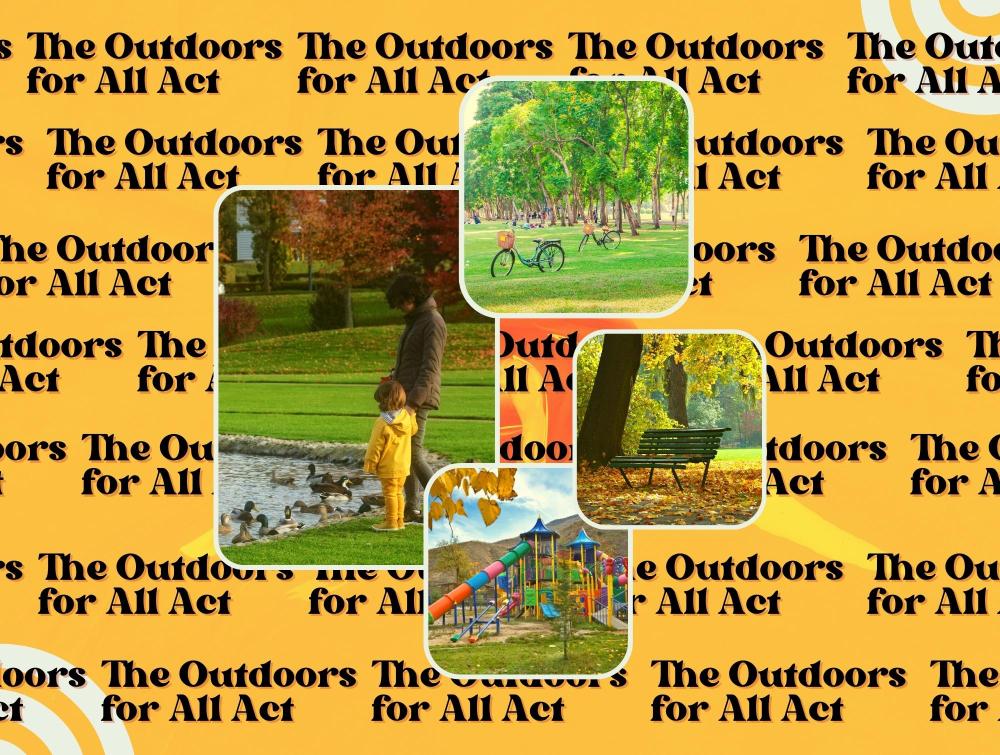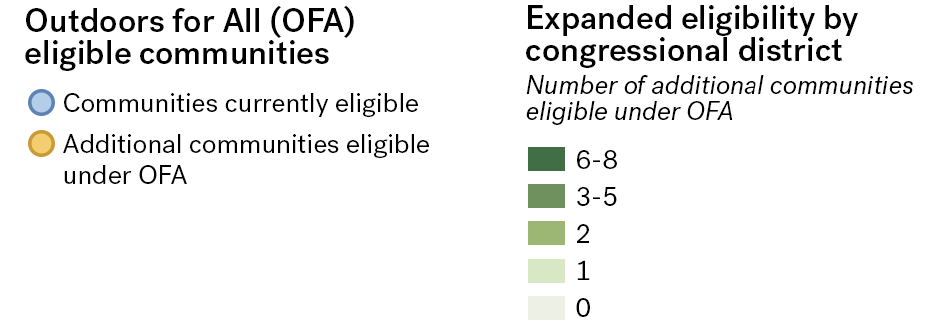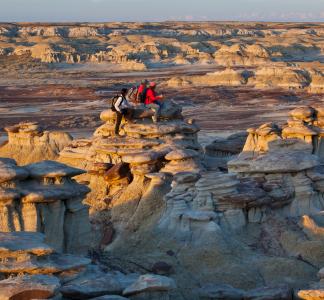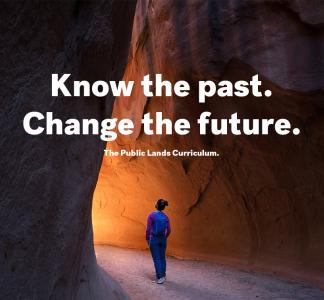4 reasons to pass the Outdoors for All Act

Collage created from Canva assets
Bill would pay to expand park access to millions
Ask yourself: What’s a day outdoors look like to you?
Perhaps it's frolicking in vast, lush meadows with your loved ones, or a challenging trek up a 14er with your pals during a downpour. Maybe you prefer to relax on a picnic blanket in a city park, munching on some cheddar crackers that are shaped like a goldfish—making you wonder if this is truly a vegetarian finger food—and watching goldfish-shaped clouds float by.
No matter what your ideal day outside entails, we can all agree that time spent outside is never wasted—it’s a valuable and restorative experience for the body, mind, and soul.
Unfortunately, about one in three people in the U.S., including 28 million children, do not have access to a quality park within a half-mile radius of their home. This disparity is particularly prevalent in low-income communities and communities of color.
And yet, we all agree—everyone should be able to enjoy outdoor experiences, regardless of where they come from or live. Access to nature is a basic human right.
So hold on to your hats folks, because the Outdoors for All Act, just reintroduced into Congress this past week by Senator Alex Padilla, Senator Susan Collins, Congresswoman Nanette Diaz Barragán and Congressman Mike Turner would bring us closer to a country with…well, better outdoor access for all!
Here’s how.
1) More parks!
“Look under those chairs, there’s a park for you! And a park for you!” — Oprah (not actually, but I wish)
The Outdoors for All Act would create new parks in under-resourced communities, benefiting nearly 33 MILLION more people in the country! We all know what more outdoor space does for communities: improves health and mental wellbeing, leads to economic growth, fights environmental injustice and builds future environmental stewards!
Maybe you have an unused barren lot in your neighborhood, something like your own special version of Parks and Recreation’s The Pit—imagine the possibilities of a new (or revitalized), close-by park! Think of the children, dang it!
Overall, more parks can create a healthier, more vibrant, and sustainable community for all visitors.
Don’t believe us, nerds!? Check out the map below to see all the communities now eligible for funding in this new version of the bill.
Pull the slider across the map to see how park funding opportunities would expand under Outdoors for All. The blue points show communities that are currently eligible for funding and the yellow points show the additional communities that will be eligible for funding with the passage of Outdoors for All. The green color scale illustrates expanded eligibility by congressional district, with darker green districts having the most to gain by the passage of Outdoors for All. Additionally, in the upper right hand corner of the map, you can click on the magnifying glass symbol to explore specific states and the layer symbol to add or remove map features.

2) Better parks!
Look, maybe you DO have a park near you, but maybe it’s…not-so-great.
Maybe there’s a broken swing set, or it easily gets flooded, or there are basketball courts without rims (where can I practice my sweet NBA Jam-learned dunk skills now?!?). Maybe the park is literally just grass and a bench, and nothing else—no trees, even!
Passing the Outdoors for All Act has the potential to enhance existing parks by providing improved amenities like upgraded playgrounds, walking paths, and sports facilities.
It can make parks more accessible to community members of all ages and abilities. As a result, enhancing existing parks can address community needs and contribute to a more inclusive and engaging outdoor experience.
3) S-tier air quality and water quality!
This bill would throw cash at communities to build projects that enhance water or air quality!
Think about how our good ol’ old-growth forests are super important to filtering out air pollution and helping people breathe easier.
Parks can help especially by absorbing and filtering pollutants—studies have found that strategically planting trees near busy roadways may significantly enhance air quality!
Parks also help to reduce stormwater runoff, blocking toxic pollutants from entering nearby waters or causing erosion. But with this bill you could build a rain garden, for instance, to help provide natural filtration and help control stormwater runoff!
4) In one corner…climate change…in the other corner…the Outdoors for All Act!
Building local parks can contribute to the fight against climate change in various ways.
Park plants and trees can help absorb carbon dioxide from the atmosphere, reducing greenhouse-gas pollution that drives global warming.
Parks are also cool—literally! They provide cooling benefits to communities by offering shade, which can help reduce the urban heat island effect. Urban heat islands are caused by a lack of tree cover and an abundance of paved surfaces, which absorb and radiate heat. By adding more parks and trees, we can lower energy costs for air conditioning, reduce air pollution levels and prevent heat-related illnesses.
Overall, increasing the number of local parks can help mitigate the impacts of climate change while also providing numerous benefits to communities, including improved public health and more livable, sustainable neighborhoods.
Time to ‘billieve’ in passing this bill
Passing the Outdoors for All Act would provide significant benefits to communities across the United States. By increasing access to close-by outdoor recreation opportunities, the act would promote physical and mental health, boost local economies and enhance the natural environment while also addressing historic inequities in outdoor access, ensuring that all people, regardless of where they live, have the chance to enjoy the many benefits of nature.



